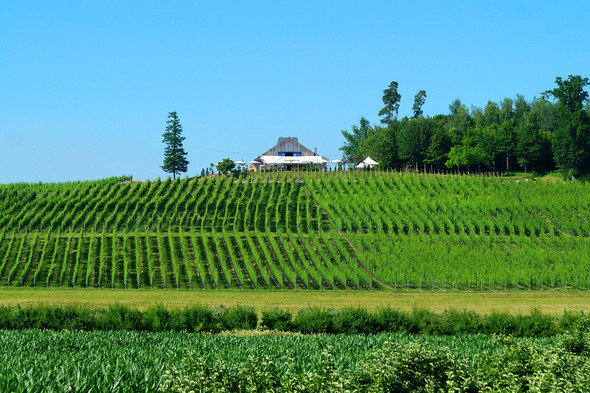After lunch in a waterside restaurant, we hesitantly asked the waiter if he happened to know where we would find the Schmidts. Not only did he know, he also gave us detailed directions. From which the second good news stems. The Schmidt Winery is in perfect harmony with its surroundings; its wines are available in the local restaurants, people working in hospitality all know its name and send their guests. So, it was easy for us to reach this beautifully situated estate. The neighbouring lands are mainly apple orchards while the vines, mostly Pinot noir and other Burgundy varieties, green the hill at the top of which stands the winery. The building is exciting (modern yet like a family), the view from the wine terrace simply fantastic. You can see the lake, the enormous mountains on the other side, the vines below…
By the way, the winery is totally a family business: the parents and their two sons work on their 8 hectares. Obviously part of the success is that in a region of just 45 hectares (the grand total of wine grapes in the area) competition is not too great. But let us not forget their innovative young head winemaker, Sebastian Schmidt, who came home after four years to take the position of cellar master at the family estate after finishing university in Vienna and work experience in Wachau (Weingut Franz Hirtzberger), followed by Burgundy, Mersault (Domaine des Comtes Lafom). This is one of the reasons why they work with Burgundy varieties. But there is another explanation too.
Here on the southern border of Bavaria we are much closer to the Swiss and Austrian markets than to the German. That is also why I went to study in Vienna. First I headed for Geisenheim but it was all about Riesling, which isn’t a problem, but the variety is not suitable for our lands. Burgundy reinforced my belief that our region is perfectly suited to Pinot noir. This variety gives us the highest quality every year.
The winery is in a special situation: it is in the area of Bavaria where the neighbouring hill is in Baden-Württemberg.
There are many similarities between the two regions. But broadly speaking, more sandstone occurs so the soils are looser and consequently the wines are lighter as you go westwards on the northern shore of the lake. It is no coincidence that the proportion of Müller Thurgau increases in that direction.
A significant proportion of the wines are sold at the cellar or the wine terrace. But they are also available at the local restaurants too. In the last 2-3 years shop sales have started to increase, but still gradually. The figures show that besides the Austrian market there is also interest from the domestic scene. But while most of their wines are sold by the end of summer – and that is the case currently – they do not want to enter a situation that aims at senseless expansion.
The quality of the wines is the most important. Everything else comes later!
A pleasant winery, very hospitable environment and lovely wines just a stone’s throw from lake Constance. And for those interested in the history of labels, go visit them and ask Sebastian!






